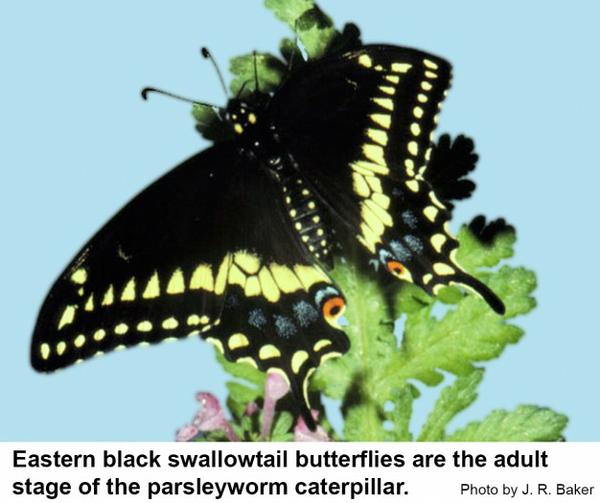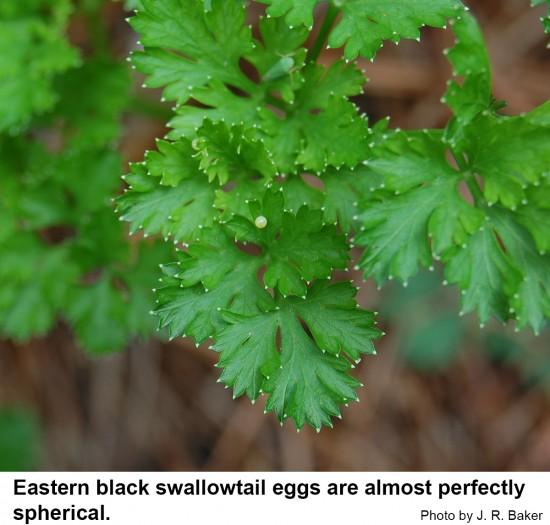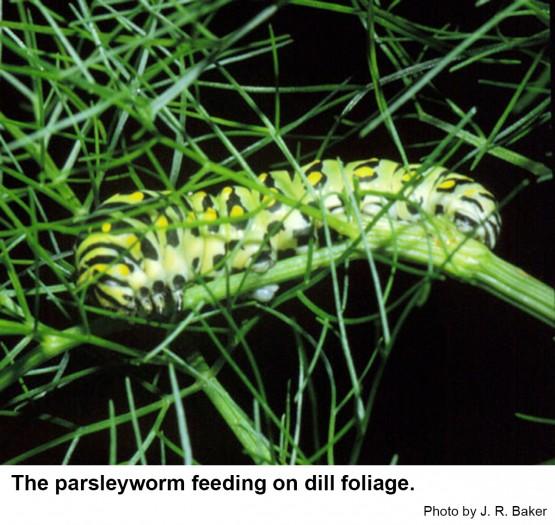Description and Biology
Parsleyworm caterpillars, Papilio polyxenes, are a little unusual in that the early stages are very dark and have a white "saddle." Older parsleyworms are green or greenish yellow and have orange-spotted bands across each segment. When the older caterpillars are disturbed, they shoot out a tiny orange forked structure called the osmeterium. The osmeterium emits an unpleasant odor that presumably defends the caterpillar from predators. When mature, the caterpillars pupate in a stage called the chrysalis, which is anchored to a stem by the hind end. The rest of the chrysalis is supported by a slender silk band. Within a week or longer, a new generation of eastern black swallowtails emerges from the chrysalides to carry on the wheel of existence. Females lay their eggs one at a time on the host leaves. We have two to three generations per year in North Carolina. This butterfly is also known as the black swallowtail, American swallowtail, parsnip swallowtail, parsley swallowtail, celeryworm, and caraway worm.
Host Plants
The parsleyworm feeds on several plants in the carrot family, Apiaceae. These include caraway, carrot, celery, parsley, parsnip, and Queen Anne's lace. Tiny parselyworms cause almost no noticeable damage, but as they get older, each stage eats more than the last so that whole stands of parsely may be decimated.
Residential Recommendation
Parsleyworms are conspicuous and are easily hand-picked but they can be persistent through the growing season. Parasites help suppress their population. The caterpillars also are susceptible to insecticides, such as Sevin or Bacillus thuringiensis.
References
- Black Swallowtail (Parsleyworm). Anonymous. No Date. Colorado Insect of Interest.
- Common name: eastern black swallowtail, scientific name: Papilio polyxenes asterius (Stoll) (Insecta: Lepidoptera: Papilionidae). Hall, D. W. 2011. Featured Creatures, Entomol.& Nematol. FDACS/DPI, Univ. Florida.
- Extension Plant Pathology Publications and Factsheets
- Horticultural Science Publications
- North Carolina Agricultural Chemicals Manual
For assistance with a specific problem, contact your local N.C. Cooperative Extension Center.
This Factsheet has not been peer reviewed.
Publication date: July 12, 2013
Reviewed/Revised: Sept. 16, 2019
Recommendations for the use of agricultural chemicals are included in this publication as a convenience to the reader. The use of brand names and any mention or listing of commercial products or services in this publication does not imply endorsement by NC State University or N.C. A&T State University nor discrimination against similar products or services not mentioned. Individuals who use agricultural chemicals are responsible for ensuring that the intended use complies with current regulations and conforms to the product label. Be sure to obtain current information about usage regulations and examine a current product label before applying any chemical. For assistance, contact your local N.C. Cooperative Extension county center.
N.C. Cooperative Extension prohibits discrimination and harassment regardless of age, color, disability, family and marital status, gender identity, national origin, political beliefs, race, religion, sex (including pregnancy), sexual orientation and veteran status.




